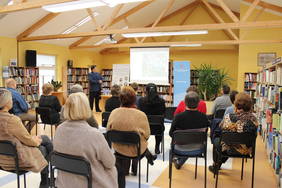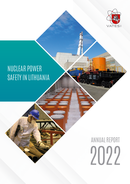In October 2022, State Nuclear Power safety Inspectorate (VATESI) and Radiation Protection Centre (RSC) organized three public meetings with the residents of Ignalina, Visaginas and Zarasai municipalities, where nuclear and radiation safety related information regarding activities in nuclear facilities and impact on the public and environment were presented.
The impact of nuclear facilities being operated in Lithuania on the environment and local population is insignificant. VATESI and RSC specialists, who spoke during the meetings, presented the provisions that are applied to ensure that the radiological impact of nuclear facilities on the population of Lithuania and the environment is minimized and do not exceed the approved limits.
VATESI Deputy Head for Radioactive Materials Control Matters Darius Lukauskas introduced nuclear facilities in Lithuania, the decommissioning process of the Ignalina Nuclear Power Plant (Ignalina NPP), the principles of radioactive waste management, the regulatory process of evaluation of safety of the nuclear facilities, the exposure of Ignalina NPP workers and the possible exposure of residents.
Rima Ladygiene, Head of the Public Exposure Monitoring Division of the RSC, presented data of researches conducted by RSC and exposure of population from various sources of ionizing radiation, discussed about the radiological monitoring of the environment.
During the meetings, VATESI and RSC representatives answered questions of the public.
In Ignalina, the participants of the meeting were mainly interested in the release of the Ignalina NPP area from the regulatory control and its state, terms of waste management, risk assessment of objects in the event of war, emergency preparedness and the planning distance of protection zones, whether the impact on the Drūkšiai Lake ecosystem was observed during the period of operation of the Ignalina NPP.
Residents of Zarasai asked whether the companies working at the Ignalina NPP are evaluated from the aspect of national security, how the actions of assessing the risks for nuclear facilities in the event of war are carried out, how the health monitoring of the people who liquidated the consequences of the Chernobyl Nuclear Power Plant accident is carried out.
Residents of Visaginas were interested in how radiation monitoring is carried out, whether there are noticeable changes in the monitoring results when the Ignalina NPP power units were operating and now, whether the cause of the appearance of tritium in the results of radiological monitoring is being investigated, how the actions of assessing the risks for nuclear facilities in the event of war are carried out, whether the activity of the Belarusian NPP and its results are noticeable in the results of environmental monitoring effect.
The main purpose of these meetings were to inform the public in the vicinity of the Lithuanian nuclear facilities about the radiation risks associated with facilities, the requirements for protection of people and the environment and what measures are taken to ensure that the radiological impact on residents and the environment is minimized and within the approved limits.








